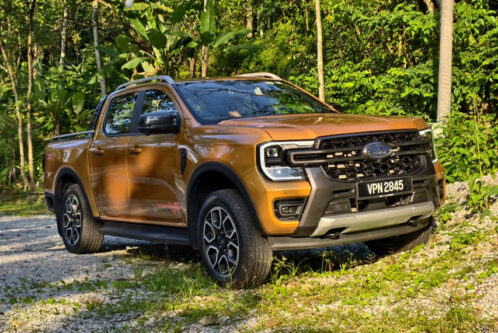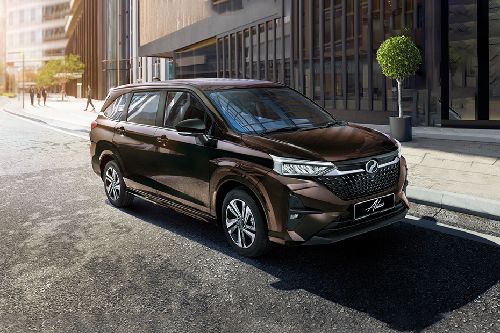Honda BR-V – Top alternatives

The Honda BR-V is the most affordable crossover sold by the Japanese carmaker in Malaysia, starting at RM 80,989 for the entry-level variant. The BR-V made its international debut back in 2015 and Malaysian debut in early 2017, and in the brand’s line-up in the country, is slotted below the HR-V and the even more expensive CR-V. According to Honda, which is currently the most popular foreign carmaker in the region, BR-V is an abbreviation for “Bold Runabout Vehicle”. Being a compact crossover, the BR-V’s underpinning is actually based on a smaller mainstream vehicle, the donor car, in this case, being the Brio hatchback. The Honda BR-V measures in at 4,456 mm in length, 1,735 mm in width and 1,666 mm in height. As for the wheelbase, the distance between the front & rear axles stretches to 2,662 mm, while the boot volume behind the last row is around 223 litres.

The Honda BR-V was designed with three rows of seats for seven people, but to also be as affordable as possible for buyers in the segment. There are only two variants of the BR-V in Malaysia: the base E variant and the range-topping V variant which sells for RM 87,701. Some of the BR-V’s most common competitors include the Perodua Aruz, Toyota Rush, and even the Proton Exora. Power for the BR-V comes from a naturally-aspirated, 1.5-litre four-cylinder i-VTEC engine that churns out 118 hp and 145 Nm of torque. It’s mated to a continuously variable transmission (CVT) and spins the front wheels. The Honda BR-V can manage a top speed of 175 kmph, while the run from naught to 100 kmph is accomplished in about 12.5 seconds.
Alternative 1 – Perodua Aruz

With prices ranging between RM 72,900 to RM 77,900 for the base 1.5X and fully-loaded 1.5AV variants, respectively, the Perodua Aruz is one of the most accomplished vehicles in its class, and one of the Honda BR-V’s toughest rivals. The Aruz’s SUV-like exterior design is also one of its other important fortes, where the BR-V’s more MPV-like styling may not be to everyone’s taste. Perodua recently unveiled the all-new Aruz (facelift), which only made this already famous and well-liked model, even more attractive for buyers. And just like the Honda, the Perodua Aruz is also a three-row, seven-seater. The Aruz measures in at 4,435 mm in length, 1,695 mm in width and 1,740 mm in height. Its wheelbase stands at 2,685 mm, while the Aruz’s boot space is 213 litres.

The Aruz is powered by a 1.5-litre naturally-aspirated four-cylinder motor that produces 101 hp and 133 Nm of shove - sent to the rear wheels via 4-speed torque converter automatic transmission. If performance is really important for you, the Perodua Aruz isn’t exactly the right wheels for you. It weighs more than the BR-V and has less power to propel it -- the result is a 0-100 kmph time of around 13 seconds, with the Aruz running out of punch at 175 kmph - exactly the same as the Honda. Some of the top safety features of the Aruz include six airbags, Anti-Lock Braking System (ABS) with Electronic Brake Force Distribution (EBD) and Brake Assist (BA), Vehicle Stability Assist (VSA), Traction Control (TRC), and Hill Start Assist (HSA).
Alternative 2 – Proton Exora

The facelifted 2019 Proton Exora was launched in the later part of May and it continues to be one of the marque’s well-received models. The Exora is Proton’s first-ever seven-seater compact MPV and is priced at RM 59,800 for the entry-level Executive trim and RM 66,800 for the range-topping Premium trim. Despite its recent facelift, the Exora is clearly the older-looking vehicle on this list, and its design sort of reflects that, too. Its 1.6-litre naturally-aspirated four-cylinder petrol engine is good for 138 hp and 205 Nm, and comes mated to a continuously variable transmission. However, the Proton Exora is quicker - ripping through the tonne-mark in 11.3 seconds, with a top speed of 185 kmph.

The 2019 Proton Exora measures 4,610 mm in length, 1,809 mm in width, 1,691 mm in height, and has a 2,730 mm wheelbase. The Exora, though, isn’t as well equipped as its rivals, with only dual front airbags, parking sensors with a reversing camera, Anti-Lock Braking System (ABS) with Electronic Brake Force Distribution (EBD) and Electronic Stability Control (ESC) on offer.
Alternative 3 – Toyota Rush

Toyota launched the facelifted 2019 Rush in October 2018 and is almost exactly like its Perodua doppelganger, only more expensive. The Rush range costs from RM 93,000 for the base 1.5G variant and RM 97,000 for the top-of-the-line 1.5S variant. Just like the Aruz, one of the biggest draws of the Rush is its styling, equipment & features, and of course, its ‘Toyota’ badge. As for its exterior dimensions, the Toyota Rush measures 4,435 mm in length, 1,695 mm in width, and 1,705 mm in height (slightly different to that of the Aruz).

The Rush gets its oomph from a 1.5-litre naturally-aspirated four-banger that makes 104 hp at 6,000 rpm and 136 Nm of peak torque at 4,200 rpm. It gets the same 4-speed automatic as in the Aruz, and has identical performance numbers like its Malaysian counterpart. In terms of its safety tech, you can get six airbags, Anti-lock Braking System (ABS) with Electronic Brake-force Distribution (EBD) and Braking Assist (BA), Hill-start Assist Control (HAC), Vehicle Stability Control (VSC), Traction Control (TRC), Blind Spot Monitor (BSM), Rear Cross Traffic Alert (RCTA), Digital Video Recorder (DVR), and a Panoramic View Monitor (PVM).
Honda BR-V Related Stories
- News
- Featured Stories
Honda Car Models
Malaysia Autoshow
Trending & Fresh Updates
- Latest
- Popular
You might also be interested in
- News
- Featured Stories
Honda Featured Cars
- Latest
- Upcoming
- Popular
Latest Honda BR-V Car Videos on Zigwheels





























































